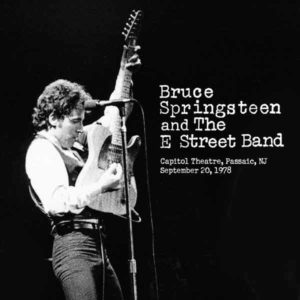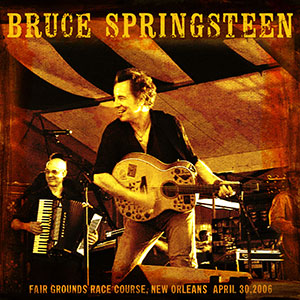
Bruce Springsteen and the E Street Band
Capitol Theater, Passaic, New Jersey, September 20, 1978
By Erik Flannigan
It was a homecoming when Bruce and the E Street Band returned to the Capitol Theater for a three-night run in September 1978. The Passaic shows were the band’s first New Jersey appearances on the Darkness tour, coming at the end of a run that saw Springsteen play 22 shows in 32 nights, nine of which took place within the 14-mile radius encompassing Madison Square Garden (three sold-out nights), the Palladium (another three sold-out nights) and the Capitol Theater. If you’re looking for the heart of the Darkness tour, look no further than the Passaic stand.
To mark the occasion, a special marquee was commissioned for the theater, and, most famously, it was decided that opening night at the Capitol, September 19th, would be broadcast live on FM stations from Maine to Virginia including WNEW-FM in New York City. The Passaic broadcast was a culmination of much of the success that had been earned on the Darkness tour, and, thanks to tapes and bootlegs of the broadcast, it was helped seal the legend of Bruce Springsteen and the E Street Band live in concert.
But the next night the pressure was off, and that’s what makes the Capitol Theater, September 20, 1978 such an exceptional performance and an essential addition to the archival download series. “It’s just me and you tonight,” says Bruce before launching into the show-opening cover of “Good Rockin’ Tonight.” If night one in Passaic was playing to Bruce’s entire east-coast fanbase listening on the radio, night two was playing for himself and many of his longtime Jersey fans.
What follows is an electric, 22-song performance that delivers much of the core ‘78 tour set along with special selections for those stalwart local supporters, including a long, band-showcasing “Kitty’s Back”; the galvanizing cover of the Animals’ “It’s My Life” (frequently played at 1976-77 shows but uncommon in ‘78); and a very rare live coupling a la the album of “Incident on 57th Street” into “Rosalita” which justifiably brings the house down. Smashing stuff.
As great as those special additions are, Darkness on the Edge of Town material is performed here at its peak, so the versions of “Badlands,” “The Promised Land,” “Prove It All Night” (with its long instrumental intro), “Candy’s Room” and the title track capture Bruce and the band at the height of their powers, augmented by the album outtakes “Fire” and “Because the Night” in equally fine form. If you’re looking for “Racing in the Street,” Bruce subs “It’s My Life” in its place, seemingly to honor an audience request you can make out clearly in the recording.
Add in future River songs “Independence Day” and “Point Blank” and there is no denying the intensity of the September 20 performance and the total commitment of the musicians. Even on tape, you can feel it as much as you hear it.
Yet the magic of a Springsteen concert is the balance of darkness and light. Here, with only 102 shopping days left until Christmas, the playfulness comes as Bruce performs “Santa Claus is Coming To Town” for the first time since 1975. Likewise, the encore is pure release, first firing a turbo-charged “Born to Run,” followed by an ebullient “Tenth Avenue Freeze-out,” “Detroit Medley” and finally, what else but “Twist and Shout.” As the latter comes to an end, a sweat-drenched Springsteen takes off his coat, throws it over his shoulder and shouts triumphantly, “I’m goin’ home!” He was already there.
Line recordings of the September 20 show have circulated for many years, initially in mono (pulled from an in-house video recording) and later in stereo from soundboard tapes. For the first time, this release comes from multi-track reels captured by the Record Plant’s mobile recording unit and mixed by Bob Clearmountain, after restoration by Jamie Howarth at Plangent Processes.
Compared to even the best of the bootlegs, Clearmountain’s mix is next level, fixing instrumental and vocal balance, while adding dimensionality, depth and a polish that this sparkling performance fully deserves. The Darkness tour has never sounded better than this.
